How to plant actinidia in spring and autumn: terms and rules for planting a seedling in open ground
Actinidia, which is also called "northern kiwi", because to taste - this is a ripe kiwi in its pure form - it is a perennial tree-like liana, which is characterized by sufficient endurance and unpretentiousness, however, only on condition of the initial correct planting.
Before planting actinidia in your summer cottage, you should familiarize yourself with its varieties, as well as choose and prepare the right place for planting and further cultivation. Let's figure it out!
There is no point in being afraid to plant actinidia in the Middle Lane (Moscow region)... She will be able to grow well and winter even in Siberia... Moreover, the actinidia of the Kolomikt species will not even need to be covered.
The plant, although exotic, but not tropical and grows not only in the South (like kiwi).
Content
When to plant actinidia in spring and autumn, in what month: optimal timing
Actinidia can be planted in the ground all year round (even in summer), especially if you purchase a seedling in a container (with a closed root system).
Planting dates in spring
As for the timing of the spring planting of a seedling with an open root system (not in a pot), then it must be carried out before the leaves bloom, i.e. until the buds open and the plant is still sleeping.
Planting in autumn
Autumn planting of actinidia seedlings in open ground is carried out in September-October, during the period of leaf fall, i.e. in the Middle Lane earlier, to the south - later. But it is strictly necessary 2-4 weeks before the first stable frost. This time is enough for the vine to take root in a new place and prepare for wintering.
In Siberia, actinidia is best planted in spring rather than autumn.
When to transplant
Accordingly, it can be transplanted both in early spring, before the leaves bloom, and in the fall, with leaf fall, in other words, it is similar to planting a seedling with an open root system.
According to the lunar calendar in 2020
You can choose the optimal date for planting actinidia seedlings in open ground. Moon calendar.
So, favorable days for planting actinidia in 2020, according to the lunar calendar, are:
- in March - 26-29;
- in April - 11-15, 24, 25;
- in May - 2-10;
- in September - 19-26;
- in October - 3-13, 18-21.
Of course, it is not always possible to get to the dacha on favorable days, so the main thing is not to land on unfavorable dates (the days of the Full Moon and New Moon, as well as the period when the Moon is in Aquarius, since this is a barren and dry sign -italicized).
Unfavorable days, according to the lunar calendar for 2020, for planting actinidia seedlings are the following dates:
- in March - 9,19-21, 24;
- in April - 8,15-17, 23;
- in May - 7,13-14, 22;
- in June - 5,9-11, 21;
- in July - 5,7-8, 20;
- in August -3, 4-5, 19, 31;
- in September -1, 2, 17, 27-28;
- in October - 2, 16,24-26, 31;
- in November - 15,20-22, 30.
According to the lunar calendar, from the magazine "1000 Tips for Summer Residents".
How to plant actinidia in the spring
Choosing and buying a quality seedling
If you want to buy high-quality and varietal plants of the desired floor, then the seedlings should be bought only in specialized garden centers or nurseries, or from trusted sellers who are responsible for their products.
Optimal purchase seedlings 2-3 years old - they take root much better than annual or older specimens.
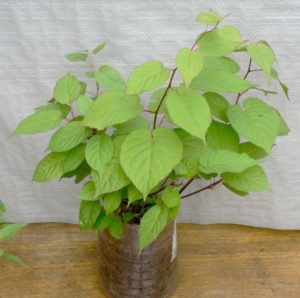
Kolomikt or Argut: choose the type
Distinctive features and characteristics of actinidia Kolomikta:
- The plant is very light and relatively fast-growing (it can reach a height of 10-15 meters).
- The leaves are softer and softer, and male plants; by August, they turn white or white-pink (but only if they grow in the sun), and women are usually simple and green.
Interesting! However, today variegation is no longer an exclusive feature of only male forms actinidia Kolomikt. Some female varieties also have a pronounced variegation.
Moreover, as mentioned earlier, under certain conditions (in the shade), not all male plants have variegation (only in the sun).
Variegated varieties of Kolomikty are ideal for landscaping in order to increase decorativeness.
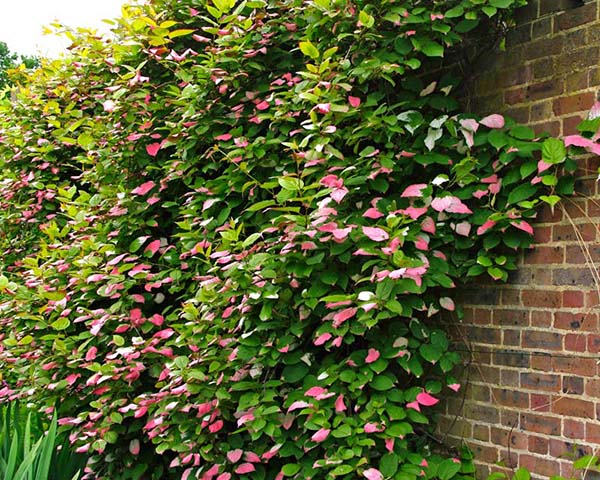
- It is able to bear fruit already for 2-3 years of life (but in cool conditions more often for 4-5 years).
- It tastes sweet, but without a bright aroma.
- The berries are smaller (up to 6-10 grams) and crumble.
- The fruits ripen in September, sometimes earlier - in late August (blooms in early June).
- Kolomikta is a more frost-resistant species than Arguta.
Therefore, in Siberia, it is recommended to plant only Kolomikt's actinidia. But in the Middle Lane (Moscow region) Arguta may well overwinter, preferably with light cover, but it is possible without it.
Distinctive features and characteristics of actinidia Arguta:
- Begins to bear fruit only for 3-4 years (in the cold northern regions, most often only in 5-9 years).
- Liana is heavier and more powerful, grows "brutally" quickly (grows up to 20-30 meters).
- Leaves are dense and smooth (hard and glossy), plain green in both male and female plants.
Therefore, it is ideal to use Arguta for landscaping a gazebo, an arch in order to shade it from sunlight and moisture (protection from rain).
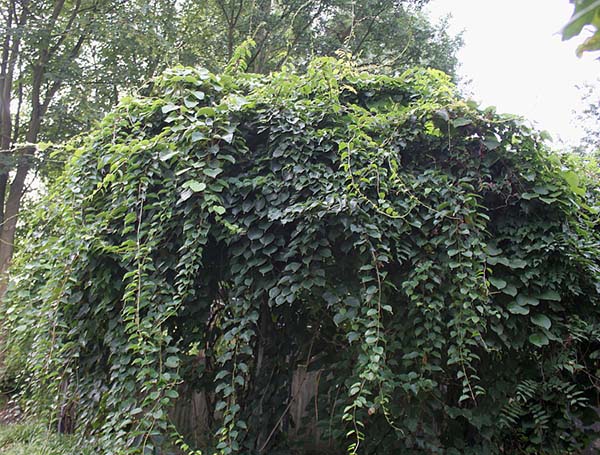
- The berries are larger (from 8-12 to 20 grams), have a very rich taste, even better than that of kiwi (something like if you mix kiwi, feijoa and gooseberries).
- The berries themselves do not fall (do not crumble).

- Ripen in late September and early October (begins to bloom in late June and early July). Become soft - so you can shoot).
They can withstand light frosts, but if there is a threat of more severe frosts, it is better to remove the hard berries - ripen well at home.
Video: actinidia Kolomikt and Argut
Landing place
Choosing the right place to plant your actinidia is one of the most important factors in successfully growing vines.
The fact is that this plant is not only demanding on the planting site, but also very fast-growing (it has truly powerful growth): in a matter of months it will envelop all the supports, trees and buildings surrounding it.
All climbing plants (vines), especially actinidia, love to be the roots were in the shade (because they have a superficial root system). At the same time vines should be in the sun (they themselves will stretch to it).
If the place is chosen relatively sunny, then at first you will need to shade the lower part of the vine, for example, using a covering material that does not allow ultraviolet rays to pass through (put the frame and stretch it around the perimeter).
Accordingly, the optimal place for planting actinidia will be north, west or east side houses, gazebos or other structures. Only do not plant on the south side, otherwise the scorching sun will constantly dry out the superficial root system of the plant and it will suffer.
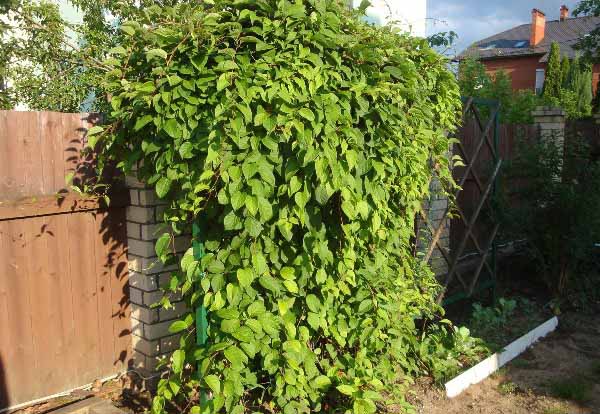
By the way! Actinidia does not give growth, therefore it can be planted along the foundation and blind area.
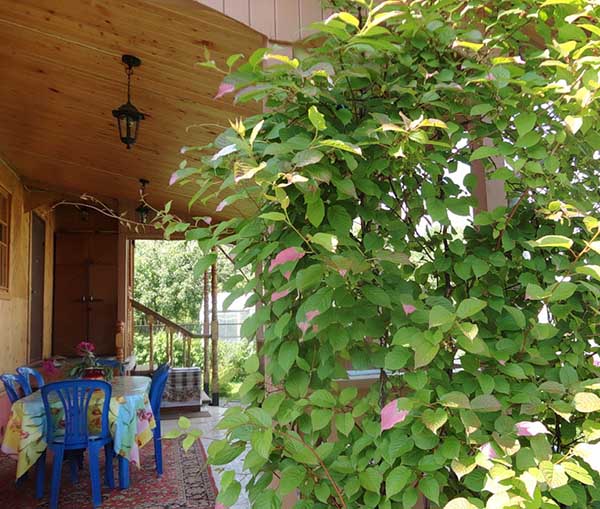
Actinidia looks very beautiful on the arches.
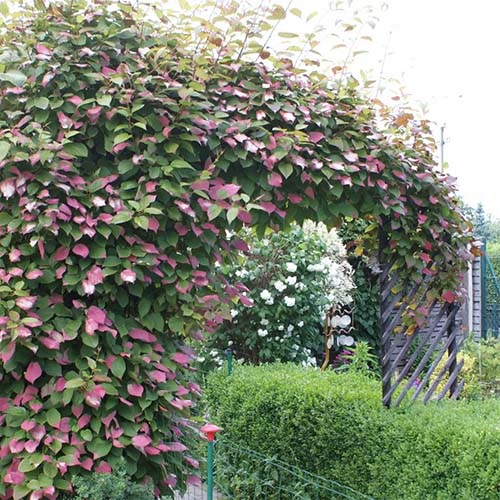
Also plant does not tolerate stagnant moisture, which means that it should not be planted in lowlands where rainwater accumulates. In this case, the groundwater at the site must lie no closer than 1.5 meters to the soil surface.
When choosing a place, of course, you should take care that the plants do not interfere with each other. Liana grows strongly over time and can simply braid and strangle a nearby shrub or branches of a fruit tree.
Concerning landing patternsthen actinidia are planted at a distance of about 1-2 meters from each other (kolomikty closer, argut farther).

Pollination
The actinidia plant is dioecious (like sea buckthorn), respectively, if you want your vines to bear fruit, then you need to plant 3-5 female plants and 1 male.
And it should be borne in mind that they do not have interspecific cross-pollination, and if you plant a male plant of the Argut species, and a female plant of the Kolomikt species, then you will not wait for the fruits!
In other words:
- No bees are needed for pollination (but desirable), the main pollination is due to the transfer of pollen by wind through the air (like corn).
- If you only have a girl, even if she blooms profusely, there will be no fruits.
- The same applies to the situation if you only have a boy - it is pointless to wait for the fruit without a girl.
However! Some varieties of actinidia may be bisexual, they also say “self-pollinating", I.e.have both pistils and stamens, and pollinate themselves. But in this case, the berries will be smaller and not as sweet.
For example, the most popular variety of self-fertile Arguta is Viti Kiwi.
Kolomikta can also be self-fertile, namely the variety Dr. Shimanovsky... However, in fact, she is a female plant: although self-pollination will be, but up to 30%. For abundant pollination, you need male plant Kolomikty, eg, varieties Adam.
How to tell a male from a female
First of all, sex can be determined during flowering:
- The female plants will have flowers with pistils (which will subsequently swell and transform into fruits) and stamens (sterile),
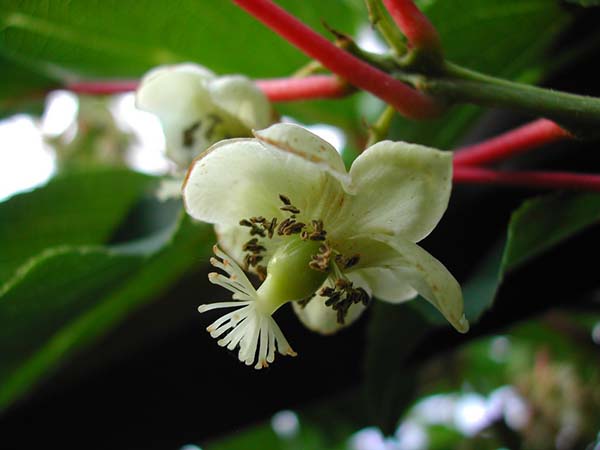
- and for men - only with stamens (barren flowers).
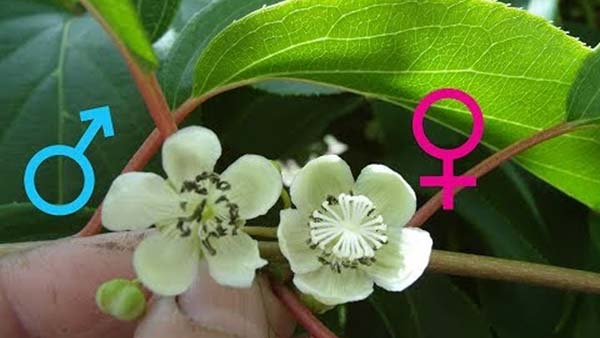
- As you remember, in the actinidia Kolomikt, the leaves of male flowers acquire color (in the sun), however, some female varieties can also be colored.
In Arguta, it is completely impossible to determine the sex in this way, because the leaves are the same.
- It was also noticed that in female plants, flowers are single along the entire length, and in male plants, several pieces together.
Video: actinidia - boy or girls
Suitable soil
Actinidia loves light and relatively fertile (in nature it grows on poor soils), but the most important thing is slightly acidic soil (or at least neutral) and absolutely does not tolerate alkaline soils. This means that:
- if you are doing drainage, then in no case use limestone;
- plentiful feeding is unacceptable wood ash (this potash fertilizer has an alkaline reaction);
- again, mulching with humus and compost is not the best idea, because it is an alkaline organic matter.
However, if your soil is acidic, then these fertilizers can and should be used, because actinidia grows well on slightly acidic soils, not acidic.
Another thing is, if you have too alkaline soil, then you, on the contrary, need to acidify it to become slightly acidic.
Planting pit: dimensions and necessary fertilizers
For planting actinidia seedlings, small planting holes are dug, about 40-60 cm in depth and width (diameter).
If you have a container seedling (in a pot), then it is just 2-3 times larger than the container itself (earthen coma).
As a rule, it is recommended to plant actinidia in a fertile substrate that can be prepared from:
- the upper fertile layer, which remained after digging a hole;
- Buckets of humus or compost (unless you have alkaline soil)
- river sand (for loosening the soil so that it is light);
- sour peat (if you need to get slightly acidic soil);
- superphosphate (100-120 grams) and potassium sulfate (60-80 grams) or even better nitroammophoska (for spring planting) or diammophoska (for autumn planting) 80-100 grams each.
Important! If you add mineral fertilizer, then it must be mixed well with the soil so as not to burn the plant roots. Moreover, the fertilizer must be at the bottom - above the drainage, and after it there is a 5-centimeter layer of ordinary fertile soil.
However, there is an alternative opinion. So, some advise conduct an experiment and not make a big pit... It is enough to dig a depression slightly larger than the root system in depth and width (literally 2-5 cm) and do not use any organic and mineral fertilizers (humus, compost or superphosphate). According to their assurances, you will be surprised how much a plant planted in this way will outstrip those that were planted "according to all the rules." Moreover, what is most surprising, it concerns planting on poor soilsrather than initially fertile. This is such a paradox, which in fact is not (according to some gardeners).
Support (trellis)
Actinidia should only be grown on a support. Without support, it will not bloom and set fruit, i.e. fruit.
What support is required for actinidia?
- Need support proportionate to the plant... Those.while the bush is small and the support is thick, you need to tie it to the support with a thin rope (twine) so that the shoots begin to curl around it (the plant is hooked).
What size you give support, this is how your actinidia will grow. Most likely even more!
- The support can be a good strong lattice or plastic mesh - the same arbor.
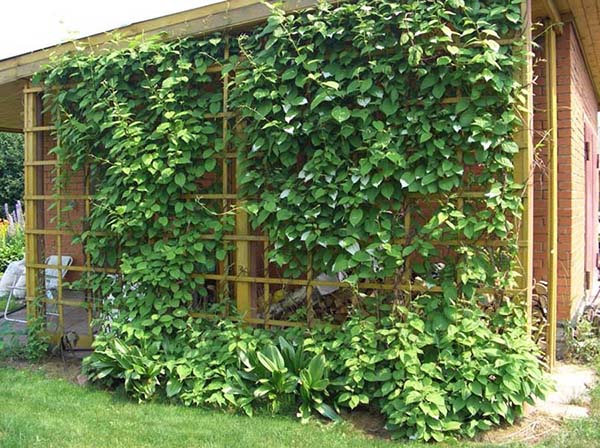
Better to have a support wooden: in this case, you will not need to take it off for wintering (wood is a warm material).
The main thing - it is undesirable to use metal or stone supports.
Video: tapestry for actinidia
Direct landing
Step-by-step instructions for planting actinidia in open ground:
- Remove the seedling from the pot and place it in the planting hole.
If you have a seedling with an open root system, then pour a mound and spread the roots down on the sides.
- Cover with earth and tamp it thoroughly so that there are no voids around the roots.

- Water abundantly. Wait until the water is absorbed and the soil settles. Water again.
Good watering is necessary in order to achieve contact between the roots and the soil.
- Add more soil.
As a result, the root collar should be at ground level, even better if it is slightly deepened than higher.
- Mulch.
- Tie to a support (trellis).
- Fence with a net from animals (cats).
Video: how to plant actinidia
Caring for actinidia after planting
After planting a young seedling, you need to carefully monitor and promptly unwind twisted young shoots, directing them to the support so that they do not strangle each other.
Alternatively, they can also be trimmed. The main thing is not to allow the shoots to twist around themselves and each other.
Of course, do not forget to water (the plant loves moisture very much, but not stagnant water), and even better right away well mulch (so that moisture does not evaporate, since the roots are superficial).
Note! Young shoots of actinidia are very fond of nibbling cats and cats, therefore, after planting, the plant must be protected in some way from their encroachment, for example, using a net.
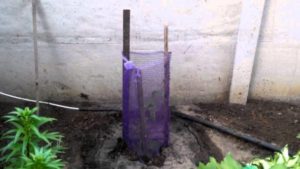
Do not forget in autumn properly prepare a young plant for winter, namely to shelter.
Advice! About, how to cover actinidia for the winter, detailed in this material.
Interesting facts about actinidia
- Actinidia fruits unlike kiwi - naked, not hairy, while their you can eat whole.
- Need to eat not green and hard berries, but soft.
Collect green berries and spread them at home to ripen. Then every day the yellowed soft berries are sorted out and selected.
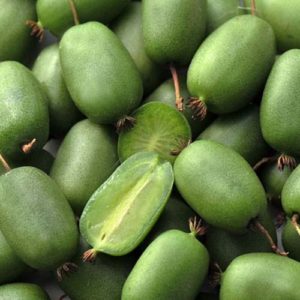
- The fruits have enough strong laxative effect.
That is why they should be eaten carefully and not in large quantities.
It's another matter if you have chronic constipation. Then the berries of actinidia, according to some reports, will help to cope with it.
- As mentioned earlier, actinidia attracts cats, because produces the same pheromones as valerian.
The main advantages of growing actinidia:
- Fast growth - liana is ideal for creating a shady gazebo, braiding and closing a fence.
- Delicious and useful fruits (especially rich in vitamin C).
- Late ripening (you can eat when there are no other berries, not counting mountain ash and viburnum).

Well, now you know how to properly plant actinidia in your area, so that soon (although you still have to wait) it will delight you with a harvest of tasty and healthy fruits, and before shading your gazebo.
Video: Actinidia or North Kiwi - description and characteristics of species, planting and care features



The spring planting of actinidia froze, what to do, the kidneys turned black
Thank you
Just wait and watch, some of the kidneys can recover
We bought seedlings of actinidia purpurea (boys, girls). While the seedlings were sent by mail, the leaves dried up. What should be done to make the plants survive?
Hello! It is necessary to plant it as soon as possible, after soaking the root system in a solution of a root growth stimulator (Kornevin, Heteroauxin) or, in extreme cases, if there is no or cannot find a root stimulator, in a growth stimulator (Epin, Zircon, HB-101). After planting, monitor the soil moisture (but do not overflow).